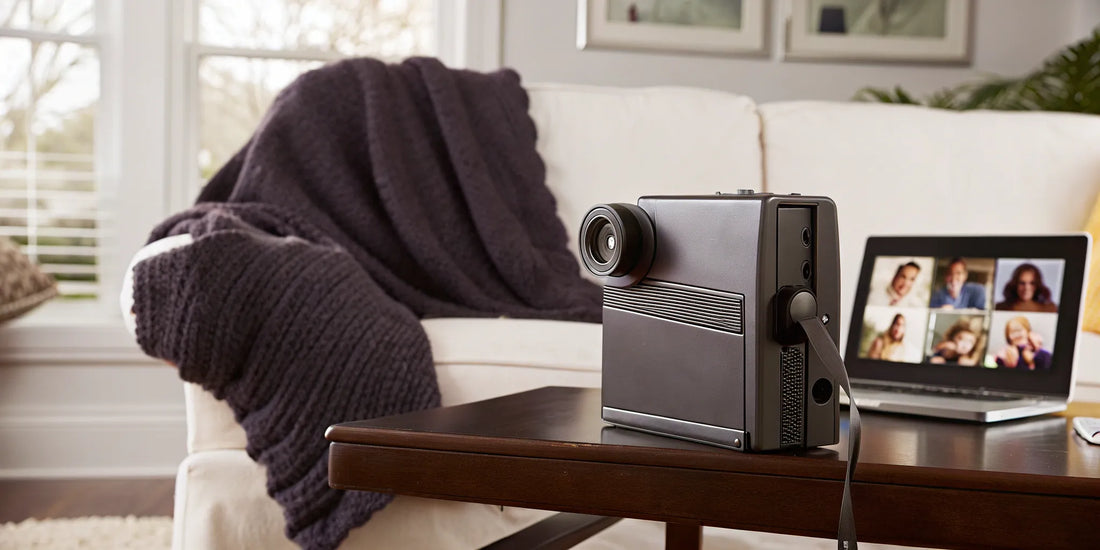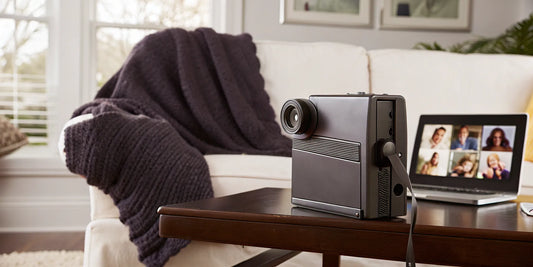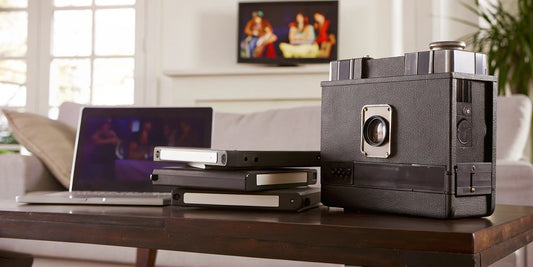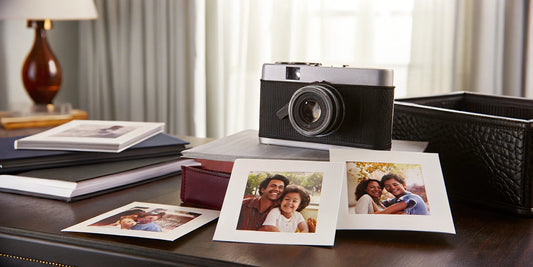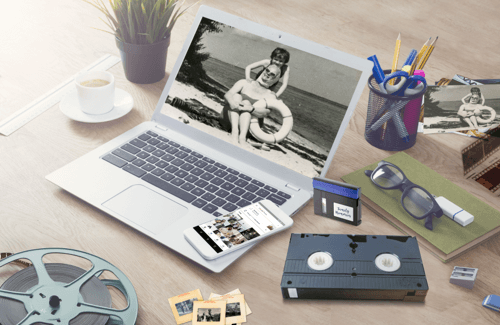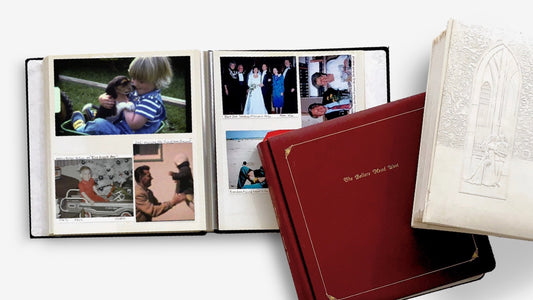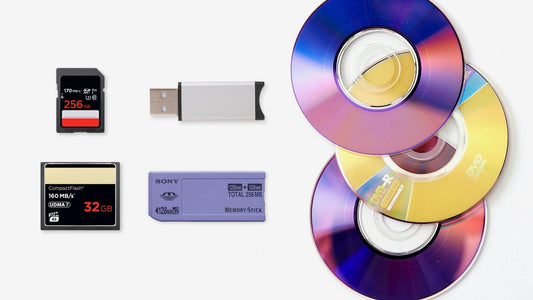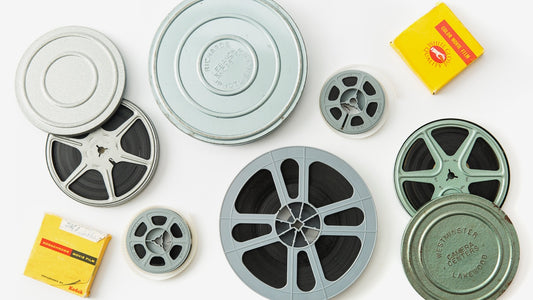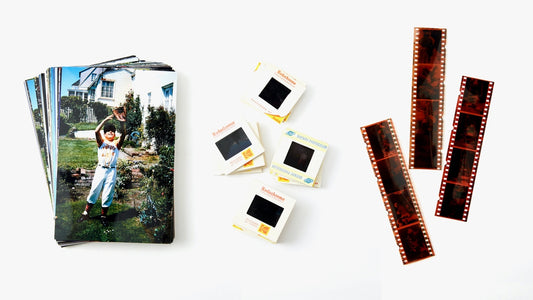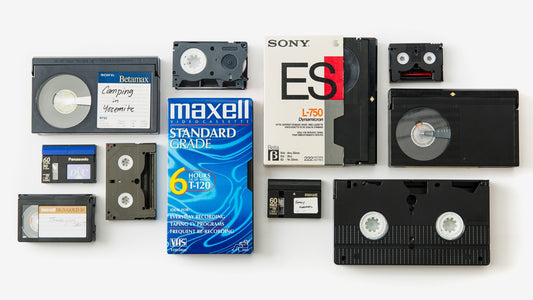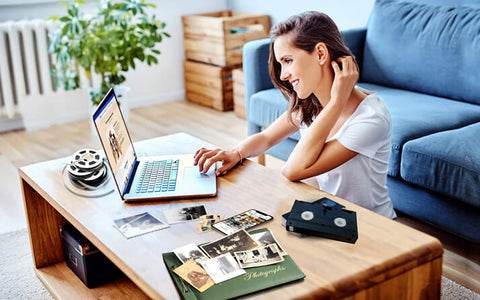The clock is ticking for your old home movies. Those Video8 tapes that hold so many precious memories are vulnerable to heat, humidity, and simple aging. The magnetic signal that stores your videos naturally weakens over the years, leading to a gradual loss of picture and sound quality. Taking action now is the best way to protect your family’s legacy. Whether you’re a tech-savvy DIYer or would rather leave it to the experts, digitizing your tapes is the only way to ensure they last. This guide will provide clear, actionable steps for preserving the moments captured on your Video8 tapes.
Key Takeaways
- Know Your Tapes by Checking the Label: Video8, Hi8, and Digital8 tapes look almost identical, so the printed text on the cassette itself is the surest way to identify which format you have and what equipment you'll need for playback.
- Choose Your Digitizing Path: You can transfer tapes yourself if you have the time and working equipment, which gives you full control. For a simpler, higher-quality result, especially with damaged tapes, a professional service is the most reliable option.
- Store Originals in a Cool, Dry Place: Even after digitizing, protect your original tapes by storing them upright in their cases in a stable environment, like a closet. This helps prevent the mold and heat damage common in basements and attics.
What is a Video8 Tape?
If you were capturing family memories between the mid-1980s and the early 2000s, there’s a good chance you were using a Video8 tape. Introduced in 1984, this format quickly became a household favorite, largely thanks to compact and user-friendly camcorders like the Sony Handycam. Its small size made it much easier to carry around than a bulky VHS camcorder, making it the go-to for recording everything from birthday parties to school plays.
These tapes hold precious moments, but they won't last forever. The magnetic tape inside degrades over time, putting your memories at risk. Understanding what kind of tapes you have is the first step toward preserving them for the future. That's why getting a video transfer is such a great way to protect those irreplaceable family videos.
A Quick Look at the Technology
So, what made these tapes work? Video8 used a clever recording method called helical-scan. Inside the camcorder, a spinning head recorded video and audio information diagonally onto the magnetic tape. This technique allowed for a lot of information to be packed into a small space, which is why Video8 tapes are so much smaller than VHS tapes. This compact design was a game-changer, allowing for smaller, lighter camcorders that made recording on the go a breeze for everyone.
Key Features of Video8 Tapes
When it comes to performance, Video8 tapes held their own. The video quality was very similar to what you’d get from standard VHS and Betamax tapes, which was perfect for home movies. In terms of recording time, a standard tape could hold up to two hours of footage. This gave you plenty of time to capture a full event without having to swap out tapes in the middle of the action. These features made Video8 a reliable and convenient choice for families everywhere.
The Video8 Family: Hi8 and Digital8
Video8 was just the beginning. The format evolved, leading to two successors: Hi8 and Digital8. Think of Hi8 as the upgraded, higher-resolution version of Video8. It offered a sharper picture but used the same physical tape. Later, Digital8 arrived, bringing the 8 mm video format into the digital age with significantly better video quality. While all three tapes look nearly identical, they are different formats. The good news is that you don’t have to be an expert to save them—a professional service can digitize all three types, ensuring your memories are safe no matter which version you have.
How to Tell if You Have Video8 Tapes
Found a box of old home movies? Figuring out exactly what kind of tapes you have is the first step toward preserving those memories. The 8mm family of tapes—Video8, Hi8, and Digital8—can look very similar at first glance, but a few key details will help you identify them. Knowing which type you have is important because it determines the kind of equipment you’ll need for playback and digitization. Let’s walk through how to inspect your tapes so you can get them ready for their digital future.
What to Look For: Size, Shape, and Style
The easiest way to start is by looking at the tape’s physical characteristics. All 8mm tapes share a similar size and shape, measuring about 3.75 inches wide, 2.5 inches tall, and 0.6 inches deep (or 9.5 x 6.2 x 1.5 cm). They look a lot like an audio cassette but are slightly thicker. Unlike a bulky VHS tape, they are compact and designed for smaller, more portable camcorders. If you have a tape that fits comfortably in the palm of your hand and has two visible tape reels under a protective flap, you’re likely holding some type of 8mm tape.
Decoding Labels and Markings
Your best clue is often printed right on the cassette. Take a close look at the tape’s label and the plastic casing itself. Most manufacturers clearly printed the format type on the front or top edge. You should see a logo or text that explicitly says "Video8," "Hi8," or "Digital8." Sometimes the packaging or the sleeve will also have this information. Checking the label is the most reliable way to know what you have, as the different formats are not always interchangeable when it comes to playback.
Spotting Signs of Wear and Tear
As you inspect your tapes, check their physical condition. Tapes can degrade over time, even when stored carefully in a cool, dark place. Look for visible signs of damage like a cracked casing, a wrinkled or tangled tape ribbon, or white, spotty mold. A musty smell is also a red flag that moisture has gotten to the tape. Because tapes get worse over time, digitizing them is the best way to ensure your memories last forever. A professional video transfer can often salvage footage from tapes that might seem too far gone.
Checking Camcorder Compatibility
If you still have the original camcorder, it can offer some major clues. The side of the camcorder will usually have a logo indicating which format it records and plays—Video8, Hi8, or Digital8. Compatibility can be a bit tricky here. A Video8 tape can be played in any of the three camcorder types. However, a Hi8 tape can only be played in a Hi8 or Digital8 camcorder, and a Digital8 tape will only work in a Digital8 camcorder. If you don’t have a working player, don’t worry—that’s where a digitizing service comes in handy.
Video8 vs. Other Common Tapes
If you grew up in the 80s or 90s, you probably remember the "format wars." Betamax vs. VHS was the big one, but another battle was brewing in the world of camcorders. When Sony introduced the Video8 format, it went head-to-head with JVC’s VHS-C tapes. Both were designed to be smaller and more portable than standard VHS tapes, making home movie-making easier than ever before. Families had to pick a side, investing in a camcorder and a library of tapes that were often incompatible with their neighbor's setup. This competition pushed technology forward, giving consumers better quality and more features with each new model.
Each format had its own fan base and its own set of pros and cons. Understanding where your Video8 tapes fit into this landscape can help you appreciate the memories they hold. While the technology might seem dated now, at the time, it was cutting-edge. The good news is that no matter which format won your family’s loyalty, you can still transfer your videos to a digital format that will last for generations. This modern approach erases those old compatibility issues, letting you focus on what really matters: the moments captured on tape. It’s the perfect way to bring all those different formats together into one unified, easy-to-share collection.
How Video8 Compares to VHS
The most obvious difference between Video8 and VHS is the size. A standard VHS tape is a chunky rectangle, while a Video8 tape is about the size of a cassette tape. This smaller size is what made Video8 camcorders so popular—they were lightweight and easy to carry around.
Video8’s direct competitor was actually VHS-C, the compact version of VHS. While both were small, Video8 tapes offered better visual and audio quality and could record for longer periods. The big win for VHS-C, however, was convenience. You could pop a VHS-C tape into an adapter and play it in your home VCR. Video8 tapes, on the other hand, required the original camcorder or a special Video8 player for playback.
The Difference Between Video8 and Hi8
As you sort through your collection, you might notice some tapes labeled "Hi8." These tapes look identical to Video8 tapes, which can be confusing. Think of Hi8 as the upgraded sequel to Video8. "Hi8" stands for High-Band 8mm, and it delivered a sharper picture with better color reproduction.
Hi8 was still an analog format, but it was a significant step up in quality. It even had the ability to record some digital information, paving the way for its successor, Digital8. To get the full benefit of a Hi8 recording, you needed a Hi8 camcorder or player. While you could often play a Hi8 tape in a Video8 machine, you wouldn't get the superior quality the format was known for.
A Look at Recording Quality
When it came to quality, Video8 had a clear edge over its main rival, VHS-C. The format delivered a cleaner picture and better sound, making for more vibrant and enjoyable home movies. With a longer runtime of up to two hours per tape, you could capture an entire birthday party or holiday gathering without having to switch tapes midway through.
The trade-off was playback flexibility. As mentioned, VHS-C tapes could be played in any VCR with a simple adapter, making it easy to share your memories with family and friends. Video8 required its own dedicated equipment. Today, that distinction doesn't matter as much. The most important thing is preserving the footage on those tapes before they degrade. A professional video transfer service can handle any format, ensuring your memories are safe.
The Gear You Need to Digitize Tapes
If you’re ready to tackle this project yourself, the first step is gathering your equipment. Think of it like assembling your ingredients before you start cooking—having everything on hand makes the process much smoother. A DIY video transfer requires a few key pieces of hardware and software to move your memories from an analog tape to a digital file. It might seem like a lot, but each component plays a specific role in getting your home movies onto your computer safely.
The main challenge is often finding working equipment, since most of it is no longer manufactured. You’ll need a way to play the tape, a way to connect the player to your computer, and software to record the footage. Let’s walk through exactly what you’ll need to get started.
Finding the Right Player or Camcorder
First things first: you need a device that can play your Video8 tapes. The best option is a working camcorder, specifically a Hi8 or Digital8 model. Many Digital8 camcorders are backward-compatible, meaning they can play older analog Hi8 and Video8 tapes, which makes them a versatile choice if you have a mixed collection.
Since these cameras are long out of production, you’ll likely need to search secondhand markets like eBay or even local thrift stores. Before you buy, make sure the seller has tested the camcorder and confirmed it’s in good working order—especially the playback function. A broken player won’t get you very far.
The Cables and Cords You'll Need
Once you have a player, you need to connect it to your computer. This is where the right cables come in. Your camcorder will have an analog output, which usually looks like a set of red, white, and yellow ports. You’ll use RCA cables to plug into these ports.
These cables don’t plug directly into your computer, however. They connect your camcorder to a separate video capture device, which acts as the bridge between your old analog tech and your modern computer. Make sure the cables you have are long enough to comfortably connect your devices without putting any strain on the ports.
Choosing a Video Capture Device
A video capture device is the essential piece of hardware that converts the analog signal from your tapes into a digital format your computer can understand. These devices typically connect to your computer via USB, making them compatible with most modern laptops and desktops.
For the highest quality transfer from Digital8 tapes, a Firewire (also known as iLink or IEEE 1394) connection is the gold standard. However, most newer computers don’t have Firewire ports, so a good-quality USB capture device is the most practical option for most people. When shopping for one, read reviews to find a model known for reliable performance and good image quality.
Picking the Right Software
The final piece of the puzzle is the software that will record the video on your computer. As your camcorder plays the tape in real-time, the capture software records the incoming video and audio feed and saves it as a digital file.
Many video capture devices come with their own basic software, which is often enough to get the job done. Alternatively, you can use software already on your computer. For Mac users, iMovie or QuickTime Player can capture video. For Windows, you might use the Camera app or a more advanced program like Sony Vegas. The key is to find software that recognizes your capture device and allows you to record smoothly.
How to Turn Your Video8 Tapes into Digital Files
Once you’ve gathered your tapes and gear, you’re ready for the main event: converting those analog memories into digital files. The process can feel a little technical, but it’s totally manageable whether you decide to do it yourself or hand it off to the pros. The most important thing is to get it done, because these tapes won't last forever. Let's walk through your options for bringing those home movies into the modern age so you can easily watch and share them for years to come.
The DIY Method Explained
Going the do-it-yourself route means you’ll be the one transferring the video from your tapes to your computer. The basic idea is to play the tape on a camcorder or deck and use a video capture device to record the playback on your computer in real-time. This method gives you complete control over the process, from naming the files to choosing the video quality. It can be a really rewarding project, especially when you see those old memories pop up on your screen. Just be prepared to set aside some time, as you’ll need to record each tape from start to finish.
A Step-by-Step Guide to Transferring Your Tapes
Ready to try it yourself? Here’s a simple breakdown of the transfer process. Before you start, make sure you have your Video8 camcorder, a computer with video capture software, and the right cables to connect everything.
- Connect Your Gear: Use your cables to connect the camcorder’s A/V output to the input on your video capture device, which then plugs into your computer (usually via USB).
- Prep Your Software: Open your video capture software and make sure it’s recognizing the camcorder as the video source.
- Cue the Tape: Put your Video8 tape in the camcorder and rewind it to the beginning.
- Start Recording: Hit the record button in your software, then immediately press play on your camcorder.
- Wait it Out: The software will capture the video in real-time as the tape plays.
- Save Your File: Once the tape is finished, stop the recording in your software and save the new digital video file to your computer.
When to Use a Professional Service
The DIY method is great, but it’s not for everyone. If you have a large collection of tapes, don’t have a working camcorder, or just feel a little intimidated by the technical steps, a professional service is your best bet. It’s also the right choice if your tapes are precious and you want to ensure the highest quality transfer without any risk. At YesVideo, our team handles every tape by hand, using professional-grade equipment to get the best possible picture and sound. Our video transfer service takes the guesswork and hassle out of the process, so you can just sit back and wait for your digital memories to arrive.
Tips for a High-Quality Transfer
Whether you’re doing it yourself or preparing tapes to send in, a little prep goes a long way. First, remember that magnetic tapes degrade over time, so the sooner you digitize them, the better the final quality will be. If you’re going the DIY route, use the best cables you can find—for Digital8 tapes, a Firewire cable often provides a cleaner signal than standard A/V cables. It’s also a good idea to clean the playback heads on your camcorder before you start. Finally, do a short test recording for a minute or two to check that both the audio and video are coming through clearly before you commit to transferring an entire tape.
Get the Best Results: Transfer Tips
Once you have all your gear ready, you might be tempted to just press play and record. But taking a few extra minutes to prepare your tapes and equipment can make a world of difference in the quality of your final digital videos. Think of it as setting the stage for your memories to shine. These simple tips will help you create a digital copy that’s as clear and vibrant as possible, ensuring your home movies look their best for years to come.
How to Clean and Prep Your Tapes
Over the years, Video8 tapes can collect dust, mold, and other debris, even when stored carefully. This grime can cause static, dropouts, or a fuzzy picture during playback. Before you start transferring, gently wipe the outside of the tape cassette with a soft, lint-free cloth. It’s also a good idea to check that the tape path in your camcorder or player is also clean. If you’re not comfortable cleaning delicate tapes yourself, a professional video transfer service handles all the necessary prep work to ensure a clean capture.
Choosing the Right Transfer Settings
The settings on your camcorder and capture software play a big role in the final video quality. Before you hit record, check your camcorder’s menu and set it to the highest available resolution. This ensures you’re capturing the most detail possible from the tape. If you’re using a Digital8 camcorder to play back your analog Video8 or Hi8 tapes, look for a digital output option in the settings. Using this will help maintain the best possible signal quality as the video moves from the camera to your computer.
Guidelines for Real-Time Recording
Digitizing analog tapes isn’t like copying a file from a flash drive; it’s a real-time process. This means a 60-minute tape will take 60 minutes to transfer. To capture everything perfectly, you’ll need to start the playback on your camcorder and simultaneously begin recording on your computer. This method ensures you capture every single frame, from the opening moments to the very end. This careful, real-time approach is the same one used for professional film transfer to preserve the integrity of the original recording.
Where to Save Your New Digital Videos
After all your hard work, the last thing you want is to lose your newly digitized files. Video files are large, so you’ll need a reliable storage solution with plenty of space. Saving them directly to your computer’s internal hard drive is a good start, but you should always have a backup. External hard drives are a great, affordable option. For extra security and easy sharing, consider using a cloud storage service. This way, your precious memories are protected from computer crashes and can be enjoyed by family anywhere. Many digital media transfer services even include cloud storage to make saving and sharing simple.
How to Preserve Your Original Video8 Tapes
Even after you’ve digitized your home movies, it’s a great idea to hold onto the original tapes. They are, after all, the source of your precious memories. But magnetic tape is fragile and degrades over time. Depending on how they are stored, Video8 tapes typically last between 10 and 25 years before the quality starts to decline. The best way to ensure your memories last forever is through a professional video transfer, which creates a durable digital copy. To give your original tapes the longest possible life, you’ll want to store them with care. Proper storage can slow down the natural aging process and protect the delicate tape from damage. Think of it as preserving a piece of your family’s history. By following a few simple guidelines, you can keep your Video8 tapes in the best possible condition for years to come, ensuring that the original recordings remain safe and sound.
The Best Conditions for Storing Tapes
The golden rule for storing any kind of magnetic tape is to find a cool, dry, and dark place. This means avoiding common storage spots like attics, basements, and garages, where temperature and humidity can swing wildly throughout the year. Extreme heat can cause the tape to warp or stretch, while moisture can lead to mold growth, which can permanently ruin your recordings. You should also keep your tapes away from direct sunlight, as UV rays can break down the tape’s chemical makeup. Another hidden danger is magnetic fields. Store your tapes away from speakers, televisions, and other electronics that could potentially erase the magnetic signal on the tape. A closet in the main part of your house is often a perfect spot.
Controlling Temperature and Humidity
To get specific, the ideal environment for your Video8 tapes is a stable temperature between 60°F and 70°F with a relative humidity of 30% to 50%. Consistency is key here. Big fluctuations in temperature and humidity cause the tape and its plastic casing to expand and contract at different rates, which can lead to damage over time. Maintaining these conditions helps prevent the tape’s binder—the "glue" that holds the magnetic particles—from breaking down, a common issue known as "sticky-shed syndrome." If you live in a particularly humid climate, using a dehumidifier in your storage area can make a huge difference in protecting your tapes from moisture and mold.
Tips for Handling Tapes Safely
How you handle your tapes matters just as much as where you store them. Every time you touch a tape, there’s a risk of introducing oils, dust, or fingerprints that can degrade the recording. Always hold the cassette by its outer edges and avoid touching the tape ribbon itself. Before putting a tape away for long-term storage, make sure it’s fully rewound. This helps maintain even tension across the tape, preventing it from stretching or sagging in certain spots. Finally, always return your tapes to their original hard plastic cases. These cases are your first line of defense against dust, dirt, and accidental damage, keeping the internal mechanisms clean and protected.
Simple Maintenance Checks
It’s a good habit to check on your stored tapes every year or so. This doesn’t have to be a major project—just a quick visual inspection can help you catch problems early. When you check them, look for any signs of white or fuzzy spots, which could indicate mold or mildew. Also, make sure the cases are clean and free of dust. Always store your tapes vertically, like books on a shelf. Storing them flat can put pressure on the tape reels and cause the edges of the tape to warp over time. If you do find a tape with suspected mold, don't play it in your camcorder, as the spores can contaminate your equipment. Instead, you can look into a professional digitization service that has experience with cleaning and restoring damaged tapes.
Troubleshooting Common Digitizing Problems
Even with the right gear, you might hit a few snags when digitizing your Video8 tapes. It’s completely normal—you’re working with older technology, after all. Don’t get discouraged if the picture flickers or the sound cuts out. Most of these issues are fixable with a little patience and troubleshooting. Let’s walk through some of the most common problems and how you can solve them, so you can get back to preserving those precious memories.
Solving Common Technical Glitches
Is your video playback looking a bit shaky, snowy, or distorted? These technical glitches are often the biggest frustration when digitizing old tapes. The issue usually stems from the age of the tape or the condition of your playback device. To get a cleaner signal, make sure you’re using a high-quality camcorder or deck that’s in good working order. For persistent jitters, a device called a Time Base Corrector (TBC) can work wonders by stabilizing the video signal. While TBCs can be a pricey investment for a one-time project, they are a key tool that professionals use to ensure a smooth, stable video transfer.
How to Prevent Quality Loss During Transfer
Your goal is to make a digital copy that’s as true to the original as possible. Every time an analog tape is copied, it loses a little bit of quality, so you want to get it right on the first try. Start by gently cleaning your tapes and the player’s heads to remove any dust or debris that could interfere with the picture. Using a reliable, high-quality video capture device is also essential for maintaining the integrity of your footage. Think of it as creating a "first-generation" digital file directly from the source tape. This direct transfer process helps you avoid the fuzzy, degraded look that comes from copying a copy.
Fixing Equipment Issues
Sometimes, the problem isn’t the tape—it’s the player. Old camcorders and VCRs can be finicky. You might run into issues like the tape getting jammed, the player refusing to eject, or mysterious playback errors. Before you panic, try the simple stuff. Regular maintenance, like cleaning the tape path and heads with a proper cleaning kit, can prevent a lot of these headaches. If your player is still acting up, it might need more serious attention from a repair service. Since finding someone who still services old camcorders can be tough, this is often the point where handing the project over to a professional service becomes the easiest and safest option for your tapes.
What to Do About Format Compatibility
Getting your old Video8 player to talk to your new computer can feel like connecting two different worlds. Your camcorder likely has analog outputs (like RCA or S-Video), while your computer uses digital inputs (like USB or Thunderbolt). This is where your video capture device comes in—it acts as a bridge between the two. Once you’ve captured the video, you’ll also want to think about the final file format. To ensure your memories can be easily watched and shared on any modern device, from your phone to your smart TV, it’s best to save them in a universal format like MP4. This simple step makes your newly digitized videos much more versatile for the future.
Related Articles
- How to Preserve DV Tapes: A Complete Guide
- Digitizing Home Movies: Step-by-Step Guide
- What to Do with Old VCR Tapes
- How to Convert DV Tapes to Digital
- Restoring Old Videos: A Practical Guide
Frequently Asked Questions
What’s the real difference between Video8, Hi8, and Digital8 tapes? Think of them as three generations of the same family. Video8 was the original, offering quality similar to VHS in a much smaller package. Hi8 came next, looking identical but providing a sharper, more vibrant analog picture. Finally, Digital8 brought the format into the digital age, recording a much clearer, higher-quality video signal onto the same style of tape. While they look alike, the technology inside is what sets them apart.
Can I play my old Video8 tapes in a newer Hi8 or Digital8 camcorder? Yes, you usually can. The camcorders were designed to be backward-compatible. A Digital8 camcorder can typically play all three formats (Digital8, Hi8, and Video8), and a Hi8 camcorder can usually play both Hi8 and Video8 tapes. The reverse isn't true, however. A basic Video8 camcorder can only play Video8 tapes, so a newer tape format won't work in an older player.
How long will my Video8 tapes actually last? On average, you can expect a Video8 tape to last between 10 and 25 years before the magnetic tape starts to seriously degrade. Factors like how it was stored and how often it was played affect its lifespan. The reality is that all magnetic tapes are slowly breaking down, which is why you might see colors fade or the picture get fuzzy over time. Digitizing them is the only way to stop the clock and preserve those memories permanently.
Is it really worth it to use a professional service instead of doing it myself? This depends on your comfort with technology and how much time you have. The DIY route can be a fun project if you enjoy tinkering with old gear and have just a few tapes. However, if you have a large collection, don't have a working camcorder, or your tapes are irreplaceable, a professional service is the safest bet. They use high-end equipment that gets the best possible quality from the tape and can often handle tapes that are in poor condition.
What should I do if my tapes look moldy or damaged? First, do not put a moldy or damaged tape into your camcorder or player. Mold spores can spread and contaminate your equipment, potentially ruining it and any other tapes you play later. A cracked casing or tangled ribbon can also cause the tape to get jammed and destroyed. In these cases, it's best to leave the restoration to experts who have the proper tools and experience to safely clean the tapes and salvage the footage.

